With the promise of fair weather and good views we headed to the top of Stinchcombe Hill for our August herb walk. A little stretch up from town, but people were able to join us by driving to the top of the hill where there’s a car park making it a much flatter walk.
We met at the trig point just along from Drakestone View point (where there is a bench at the end of promontory with fine views across Stancombe Park to the Tyndale Monument on the next ridge of hills). The What3Words location for this point was, appropriately: ///asleep.ripen.strides – we woke ourselves up with a lovely sunny stride along the hilltop as the blackberries, sloes and wild rose hips ripened.
Plants, place and people
While the herbs are our focus, it’s aways interesting to understand the context we’re seeing them in. Plants are an integral part of the landscape, each shaping the other. They put their imprint on us, as we put our imprint on them.
Ancient people
The promontory that we were stood on has fantastic views right across the Severn Vale, across to Wales and down to Bristol, and then a vast sweep across the Cotswold Hills as they stretch out to the east.
This area has been very recently cleared, as regular visitors to the hill will know. Not only has the removal of many trees (largely by necessity due to ash die back) opened up the far-reaching views, it has also emphasised the undulations of the ground beneath our feet. These various dips and ditches are the remnants of the (supposed) Iron Age fort that once served as an important defence and look-out post for those living here a millennia or more ago.
Ancient plants
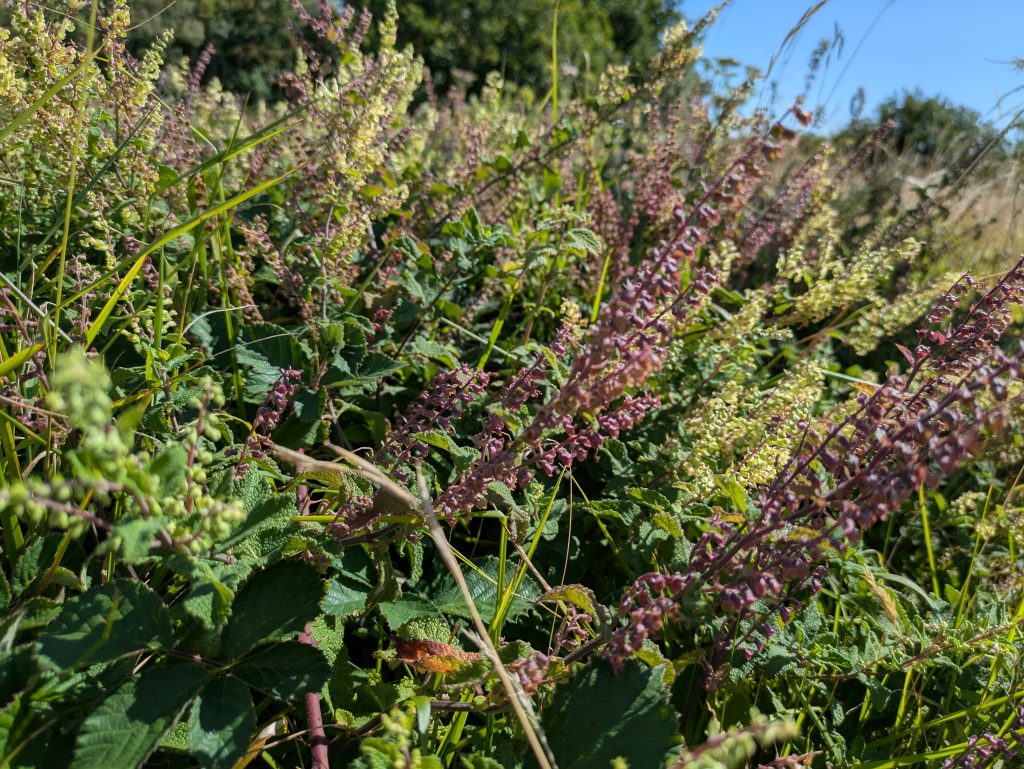
Seeing evidence of ancient habitation on the hill made us wonder whether some of the herbs we came across had been introduced to support those living in their proximity. In particular a patch of woodland germander (also known as wood sage), looking very much like a sage plant with its grey/green crinkly leaves, would likely have been used medicinally, or to flavour drinks (one of the options before we discovered hops). It is our equivalent of the dittany plant favoured on the island of Crete where it was used medicinally and in cooking. The plant on Stinchcombe Hill was very bitter in taste. The plant has a common name of ‘Hind Heal’ as these animals will eat it when they are sick or wounded. It can be used in a poultice to cleanse old sores (ideally combined with comfrey and ragwort for this purpose). A fragrant snuff would be made from the dried leaves which is effective against nasal polypi. And as a strewing herb it was thought to deter snakes.
Monumental spikes
This late summer season sees plants reach their zenith in terms of height and fullness. Two particularly impressive examples that put on a lot of vertical growth during just one season were the Verbascum and rosebay willow herb.
Verbascum
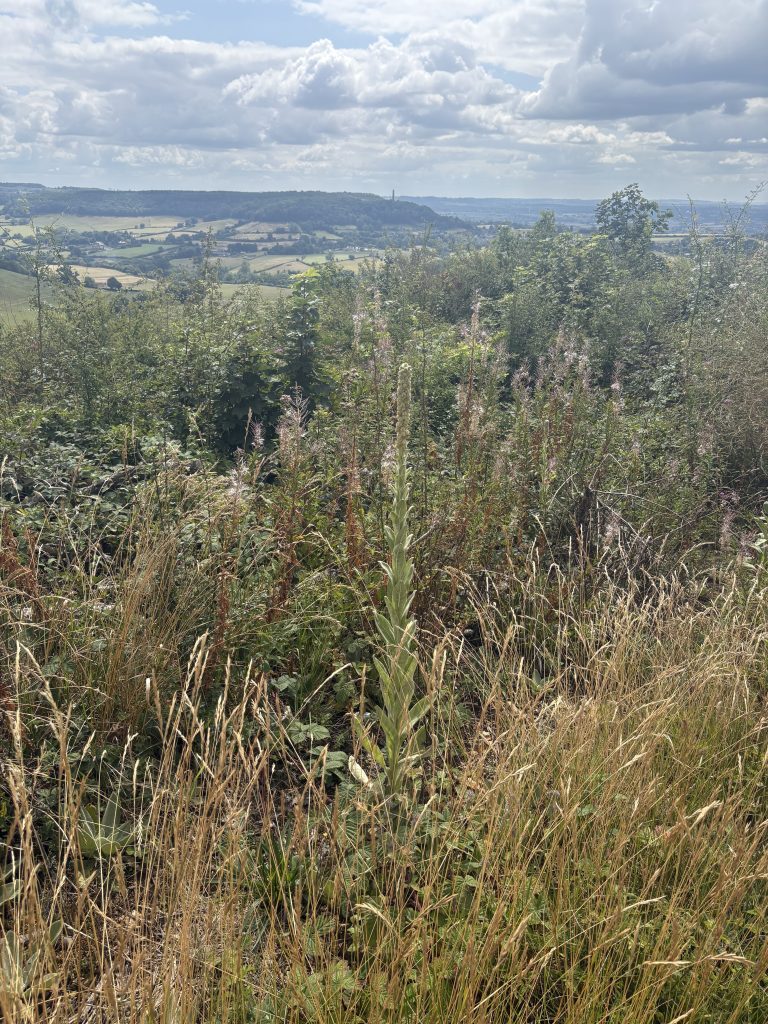
Verbascum starts to show itself much earlier in the season as a rosette of fluffy leaves, pale grey/green in colour and so covered in downy fluff they look like rabbits’ ears, and are beautifully soft to touch. From this rosette, a tall spear emerges in later summer, with yellow flowers gradually opening on all sides. Multiple spikes of Verbascum covered the promontory, a natural echo to the phallic Tyndale monument on the next hill along.
Mullein is much used in herbal medicine, valued for helping with respiratory issues. To benefit you can gather a mullein leaf, leave it to dry and then chop or crumble it ready for use in herbal teas. I like to combine mullein with marshmallow root, both mucilaginous plants that help to coat and soothe sore or inflamed skin. Together they make a good tea to stop an irritating cough in its tracks.
Rosebay Willow Herb
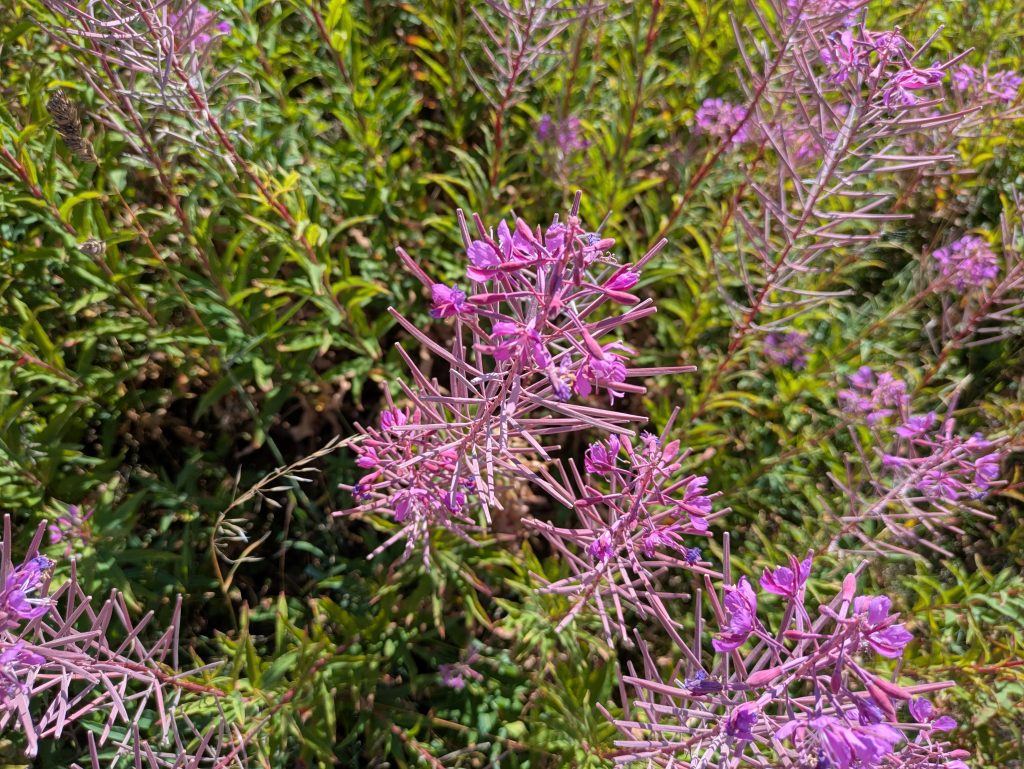
As we’ve mentioned on previous walks, rosebay willow herb was little known in these parts 100 years ago, which is surprising given its dominance today. You will probably have seen banks of rosebay willow herb as you drive along, it seems even more dominant on our roadsides now than cow parsley. It has spread along roads and railway lines as its abundant fluffy seed heads are ideally suited to being caught in the slip stream and transported miles. During the summer you can watch the pink flowers open up in turn from bottom to top on the flower spike. By now these have mostly turned to curly wisps of seed head.
Those who visited the Herbal Takeover were able to try freshly made Ivan Chai, the traditional Russian black tea made by fermenting the leaves of rosebay willow herb. It is very pleasant and fragrant.
Hemp Agrimony
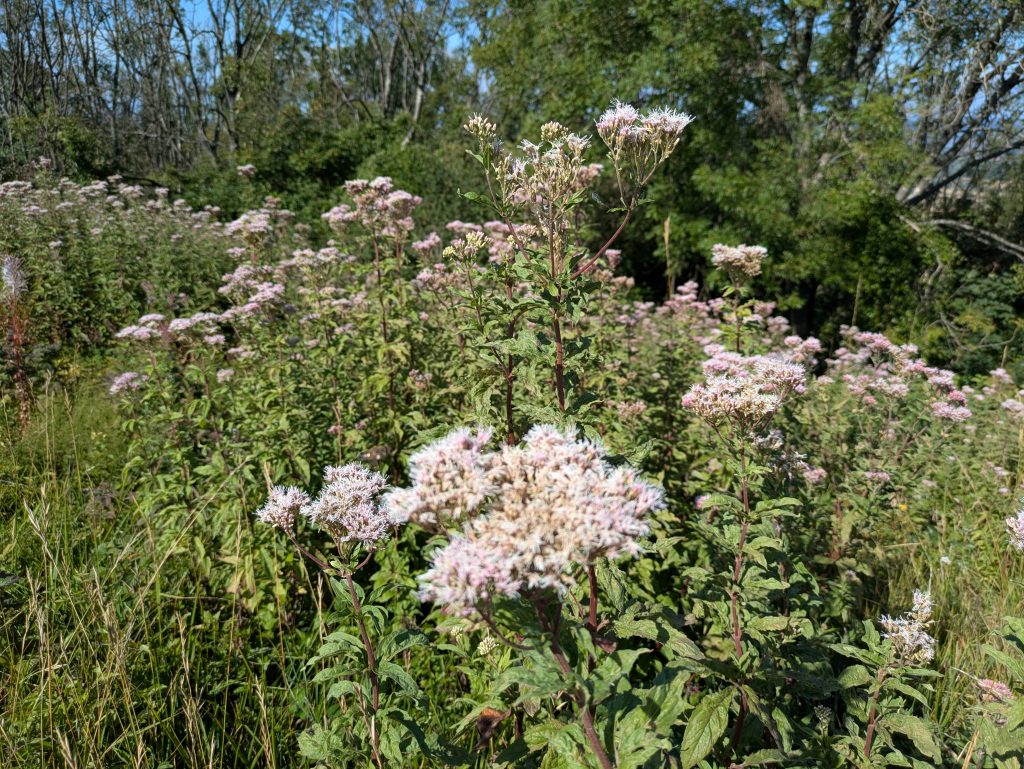
If you’re looking for a natural or wild feel in your garden, a great plant to introduce is Eupatorium cannabinum otherwise known as hemp agrimony. It has a solid, sturdy presence while being delicately colourful with its pinky purply heads of flowers.
Once you notice hemp agrimony, you’ll be spotting it everywhere. Some will know it by the common name of ‘Joe Pye Weed’ – a general name for a few herbs within this species. But who was Joe Pye? If history relates correctly, he was a First Nations tribal leader, with the actual name Joseph Shauquethqueat, though the English name Pye was in use among Mohicans. One tale suggests a whole community was saved from typhus through the use of Joe Pye weed, but it’s not clear quite how the person, the event and the plant’s name stack up chronologically.
The name sweet Joe Pye Weed is typically referring to Eupatorium purpurem; the plant recommended by the RHS for garden use is Eupatorium cannabinum, also known as hemp agrimony. This is quite a misleading name. Agrimony is a different plant and has the latin name Agrimonia eupatoria. The ‘cannabinum’ of hemp agrimony, may make you think of Hemp (Cannabis sativa), especially as the leaves look like hemp (though they look like five pointed leaves, closer inspection will show a central leaf with then two deeply divided outer leaves). It’s this leaf-a-like that has led to the plant being called ‘hemp’ and the confusion with ‘agrimony’ dates back to Pliny (c.2000 years ago) when he called Agrimony ‘eupatorium’.
Maybe we should just use the common name of ‘Raspberries and cream’ which nicely describes the colour of its flowers. Another name for the plant is ‘Holy Rope’ as it was believed it was used to make the rope with which Christ was bound on the day of his crucifixion. It is believed that bread placed on a bed of hemp agrimony leaves will not go mouldy. Hemp agrimony is considered to be toxic, the only animal known to eat it is goats. It is however a lovely resting place for butterflies and the many pollinators who feast upon it.
Colourful herbs
We were happy to find plenty of St John’s Wort growing wild on the hill, it’s starry yellow flowers yielding a red oil. Intermingled were baby blue flowerheads of Scabious, sometimes called the ‘pincushion flower’ which describes its shape well. They are a very pretty sight, and also a useful herb, traditionally used for skin disorders – the name ‘Scabious’ is a clue, it’s derived from the latin scabere ‘to scratch’. Scabious was a remedy for those suffering from scabies – an ugly affliction to associate with a pretty plant. Equally good for eczema, rashes and cracked skin.
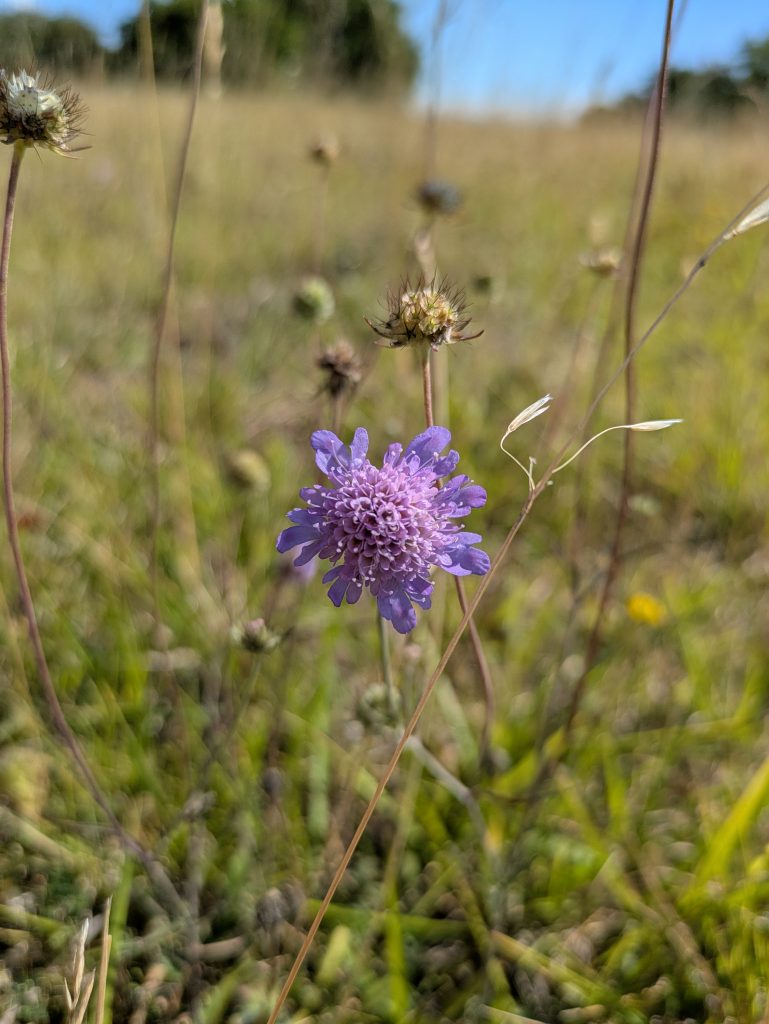
Another delicate blue flower, though less prevalent (we only saw a couple of clumps) is harebell. It has such fragile thin stems it’s a wonder it can hold the bell shaped flowers. They certainly weren’t abundant enough to be gathered, but, as well as being edible (leaves either added raw to salads or cooked as greens) their roots have been used medicinally for respiratory problems and to treat ear aches and sore eyes. Their blue colour has been used in dyes, particularly in creating tartans. A mysterious little plant, they also have many magical associations. Known variously as ‘witches thimbles’ or ‘fairy bells’ they are symbols of good luck. We were happy to find them.
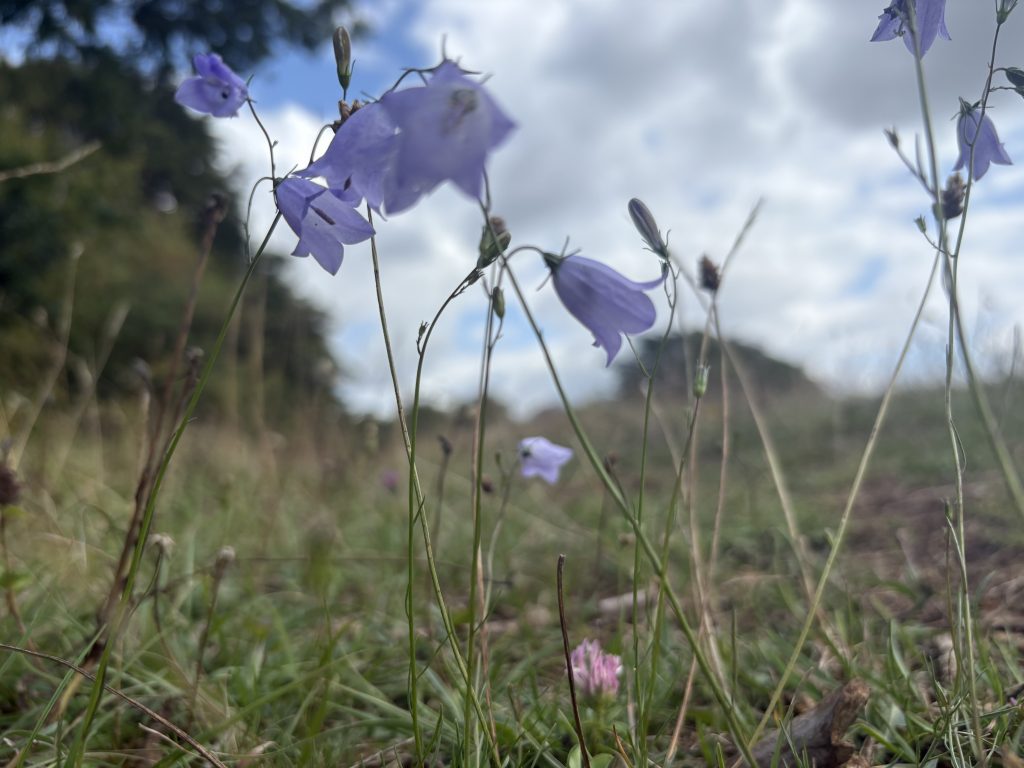
Trees, trade and terrtiory
The evidence of ash die back is clear to anyone looking at the trees on the slopes of Stinchcombe Hill. While beech dominates, there are plenty of leafless skeletons showing where the ash has succumbed. While we’ve become used to seeing the hillside covered in trees, most are actually relatively recent introductions. When the furniture makers Bymacks moved to Dursley in the mid 20th Century, they planted many areas (including along the Horsley Valley) with beech and ash trees. The clearance that has been necessitated on the hill now due to the disease is in fact restoring the landscape to how it would have been a hundred years or more ago when grazing was more common on the slopes.
As is natural, the removal of trees provides opportunity for new growth. Over the autumn robot mowers will be introduced on parts of the hill to keep the scrub at bay, thus providing greater opportunity for the plants and flowers typical of limestone and chalk to re-establish themselves.
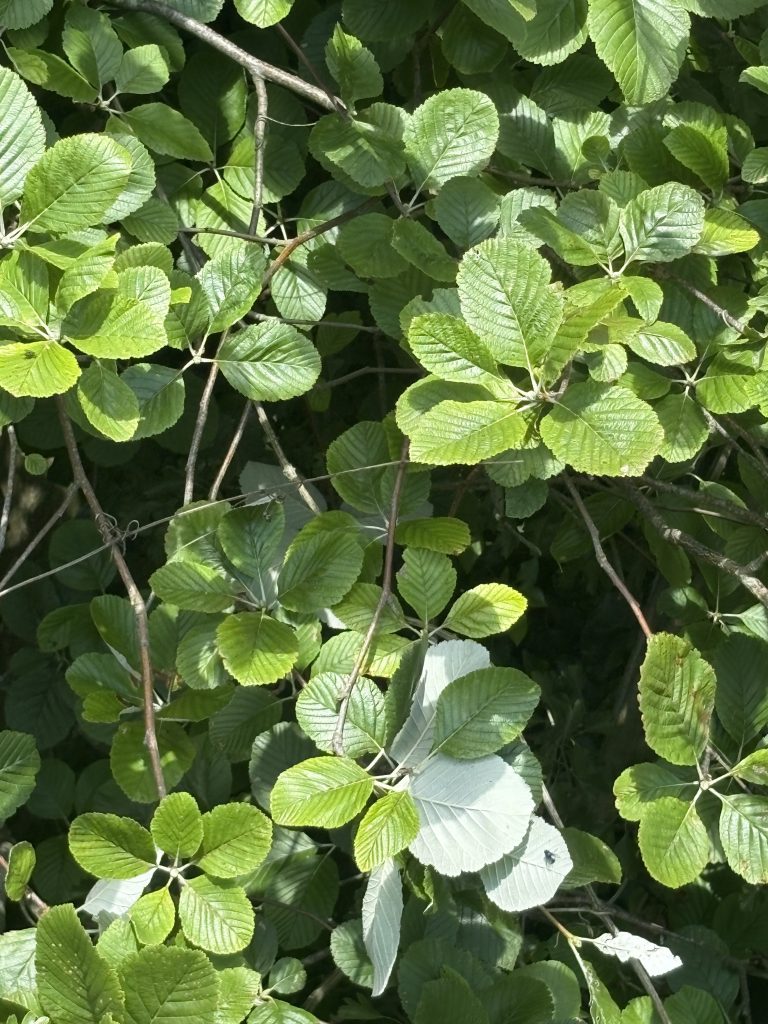
A whitebeam tree stood out among the others – which is very much what it was positioned to do. Whitebeam trees have lovely round leaves with a silvery-white underside which catches the sunlight as they flutter in the breeze. Standing out as they do, they make perfect marker trees and were thus often planted to indicate a boundary.
Sloe Sloe Quick Quick Sloes!!
The blackberries have been early this year, and all other tree fruits are following in quick succession, with an abundance I cannot remember having seen before. Something about our odd combination of rain and sun this year (and last) has led to a bumper crop of berries. Do beware, the weather lore that suggests nature provides a plentiful autumn harvest when she needs creatures to be prepared for a harsh winter, we’re due a shocker if this is true.
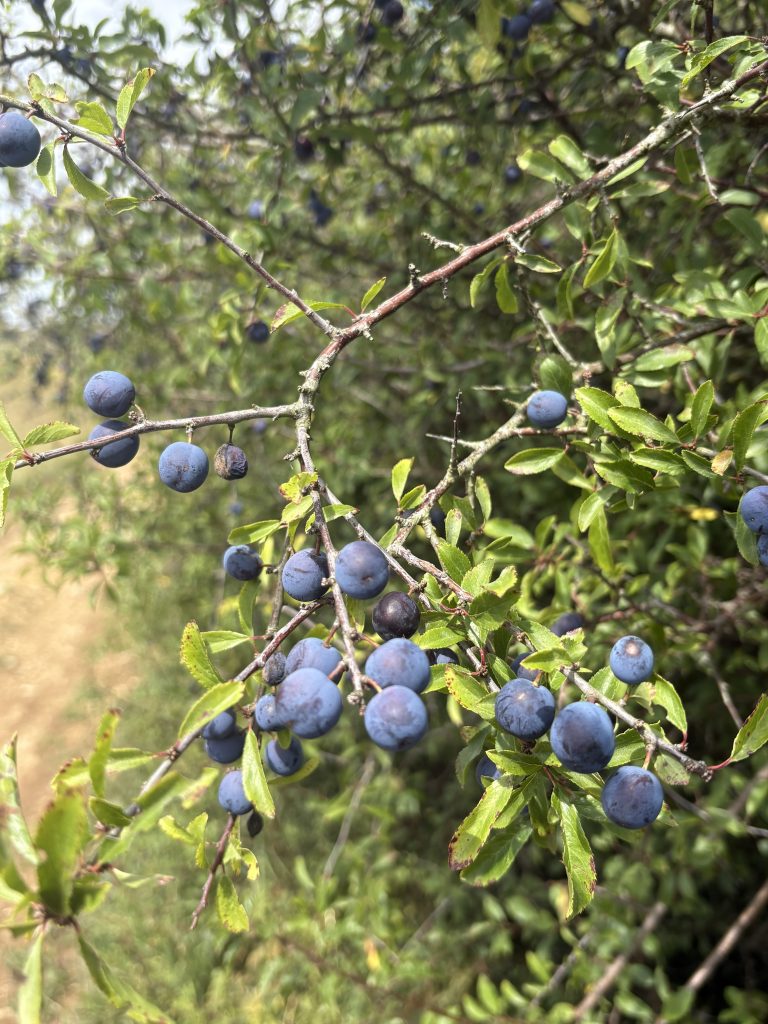
As well as bunches of shiny red haws on the hawthorn, the most startling array is on the blackthorn – hundreds, probably thousands, of deep blue sloes.
If you’re tempted to try one of these straight from the hedge you will find out just how astringent they are (cue tongue-drying, mouth-puckering grab for water). Tradition says they need the frost to bring out their sweetness. Good luck with that, especially with them arriving so early in the year. Alternatively, you can gather them and pop them in the freezer. The most common use is in creating home made sloe gin (add half their weight in sugar to the sloes then put in a jar and cover with twice their weight of gin, leave to steep for as long as you can – until Christmas likely – then strain and you should have a lovely sweet, and quite pokey, warming liqueur to share with friends), they can also be added to a hedgerow jam mix.
Thirty in Thirty – our challenge to you
If you missed the opportunity to join our walk, it’s still worth heading up to Stinchcombe Hill and taking your own stroll along the promontory to Drakestone Viewpoint to see what you can find. It’s an easy and pleasant walk along the path, especially if you chance upon a sunny day. Our experience suggests there’s potential to spot at least thirty different plants in just half an hour.
Can you spot thirty plants in thirty minutes?
Here’s our list as your ‘spotter’s guide’, there may be more that you notice, the scene is changing every day.

If you want to improve your plant spotting, know more about the plants you find, or share your knowledge about the plants you love, join one of our herb walks. We’d love to see you, first Saturday of the month, 10am.
In September we’ll be celebrating our first anniversary of herb walks by returning to the site of our first walk, the Rackleaze Nature Reserve in Cam (behind Tescos, access it by walking past the Post Office and turn right down the path). We’ll meet at Tesco’s post box at 10 am on Saturday 7th September.

Leave a Reply